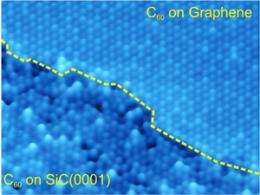Graphene decoupling of organic/inorganic interfaces

(Phys.org) -- Cryogenic ultrahigh vacuum scanning tunneling microscopy (STM) was employed by researchers in the Center for Nanoscale Materials Electronic & Magnetic Materials & Devices Group at the Argonne National Laboratory to uncover exceptionally weak molecule-surface interactions between fullerene C60 deposited onto epitaxially grown graphene on silicon carbide substrates.
The first layer of C60 molecules self-assembles into well-ordered close-packed islands. In situ scanning tunneling spectroscopy reveals a highest occupied molecular orbital–lowest unoccupied molecular orbital gap of 3.5 V, which is close to the value of solid and gas-phase C60. This finding indicates a significantly smaller amount of charge transfer from the C60 to the graphene as compared with C60 adsorbed onto metallic surfaces.
Usually interface effects dominate over the properties of adsorbed molecules. Here, however, a perfect two-dimensional material (graphene) has completely decoupled the organic system from the charged interface states of the silicon carbide surface reconstruction. Improving molecule-based organic photovoltaics and biosensors relies on minimal substrate-molecule interaction to preserve intrinsic molecular functionalities, which was achieved in this case via an inert graphene "barrier" layer.
More information: J. Cho et al., Nano Lett., 12, 3018 (2012) DOI: 10.1021/nl3008049
Journal information: Nano Letters
Provided by Argonne National Laboratory



















